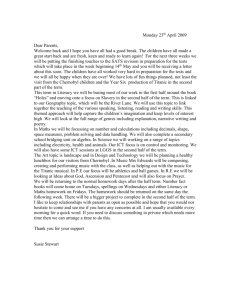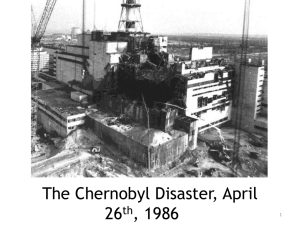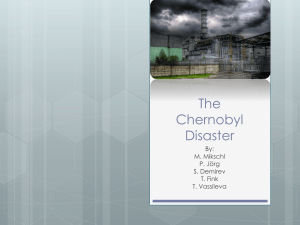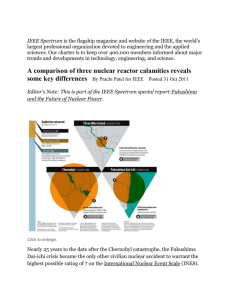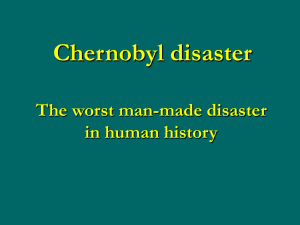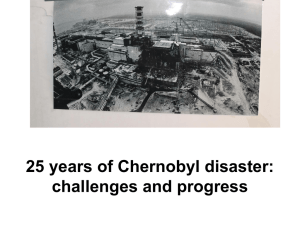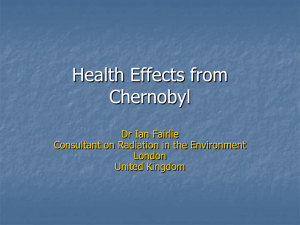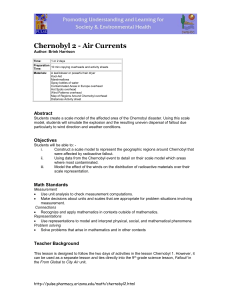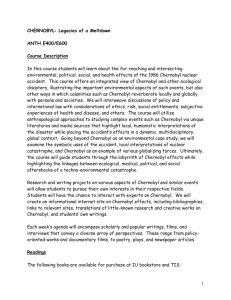Chernobyl and Alternative Energy Sources- English
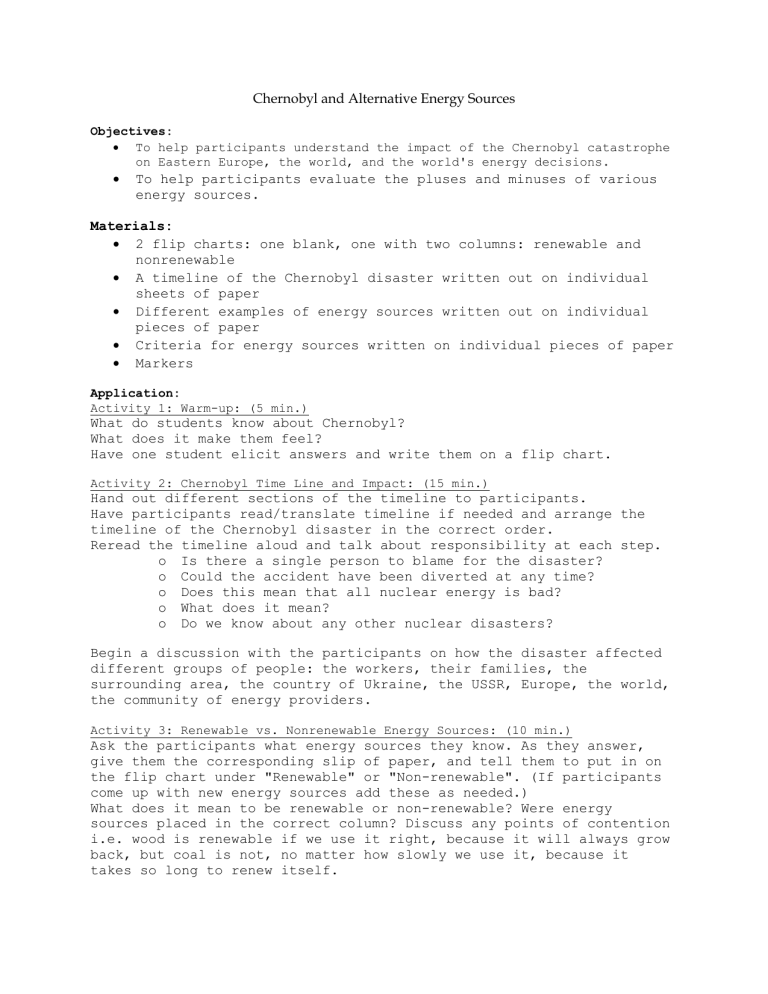
Chernobyl and Alternative Energy Sources
Objectives:
To help participants understand the impact of the Chernobyl catastrophe on Eastern Europe, the world, and the world's energy decisions.
To help participants evaluate the pluses and minuses of various energy sources.
Materials:
2 flip charts: one blank, one with two columns: renewable and nonrenewable
A timeline of the Chernobyl disaster written out on individual sheets of paper
Different examples of energy sources written out on individual pieces of paper
Criteria for energy sources written on individual pieces of paper
Markers
Application:
Activity 1: Warm-up: (5 min.)
What do students know about Chernobyl?
What does it make them feel?
Have one student elicit answers and write them on a flip chart.
Activity 2: Chernobyl Time Line and Impact: (15 min.)
Hand out different sections of the timeline to participants.
Have participants read/translate timeline if needed and arrange the timeline of the Chernobyl disaster in the correct order.
Reread the timeline aloud and talk about responsibility at each step. o Is there a single person to blame for the disaster? o Could the accident have been diverted at any time? o Does this mean that all nuclear energy is bad? o What does it mean? o Do we know about any other nuclear disasters?
Begin a discussion with the participants on how the disaster affected different groups of people: the workers, their families, the surrounding area, the country of Ukraine, the USSR, Europe, the world, the community of energy providers.
Activity 3: Renewable vs. Nonrenewable Energy Sources: (10 min.)
Ask the participants what energy sources they know. As they answer, give them the corresponding slip of paper, and tell them to put in on the flip chart under "Renewable" or "Non-renewable". (If participants come up with new energy sources add these as needed.)
What does it mean to be renewable or non-renewable? Were energy sources placed in the correct column? Discuss any points of contention i.e. wood is renewable if we use it right, because it will always grow back, but coal is not, no matter how slowly we use it, because it takes so long to renew itself.
Pluses and minuses: 10 min.
Ask the participants what we need to worry about when we are choosing energy sources (as consumers or providers.)
Place the criteria on the board. Have participants in pairs take one source of energy and evaluate the pluses and minuses according to each criterion. Have them present to the rest of the group.
Chernobyl Timeline:
1) On April 26, 1986, the technicians at Chernobyl Nuclear Power
Station in Ukraine began a systems check.
2) Due to an overlook in the security system, a chain reaction was triggered that couldn't be stopped.
3) Reactor 4 exploded, releasing a cloud of radioactive material into the atmosphere.
4) 32 people died immediately.
5) Almost 150,000 people were evacuated from Ukraine and Belarus after a short delay.
6) Radioactive material rained down on Europe for 15 days.
7) The birth rate in areas around Chernobyl has decreased.
8) Increased cases of cancers and psychological consequences have been found in the areas surrounding Chernobyl.
9) Fear of another catastrophe has lessened the world's interest in nuclear power.
Examples of Energy Sources:
Renewable: solar power, wind, hydroelectric (wave and river), wood, bio-oils, thermal
Nonrenewable: coal, oil, gas, and nuclear power
Criteria for Energy Sources:
Safety, renew ability, cost, environmental impact
Additional Information on Chernobyl
On April 26 th , 1986 the world’s worst nuclear power accident occurred at Chernobyl in
Ukraine. At the time of the accident, the Chernobyl nuclear power plant, located 80 miles north of Kiev, had four reactors. While testing reactor number 4, workers disregarded numerous safety procedures. At 1:23 am, a chain reaction in the reactor became out of control, creating explosions and a fireball, which blew off the reactor’s heavy steel and concrete lid. The
Chernobyl accident killed more than 32 people immediately, and as a result of the high radiation levels in the surrounding 20 mile radius more than 13,500 people were quickly evacuated.
The explosion and the following graphite fire spewed some 185 million curies of radioactive debris on the city of Pripyat and the surrounding area. The radioactive dust spread by air currents throughout Eastern, Northern, and Central Europe particularly affecting Belarus,
Ukraine, and Russia. Next to the atomic bombs dropped on Hiroshima and Nagasaki, it remains the world’s worst nuclear tragedy. It’s consequences, which have already been enormous, shall remain with the planet for the next 250,000 years.
Since the very first day of the explosion, Chernobyl was and remains a political football.
Information about the accident at Chernobyl was initially suppressed by the USSR, only coming to light when scientists in Sweden noticed an unusual amount of radioactive particles in the air and traced the cloud of particles back to Ukraine. Depending on the source, the death toll over the past ten years attributed to Chernobyl varies from the initial 32 to some 100,000. Some people claim that millions of people are suffering from radiation-related diseases. Others insist that these illnesses are psychosomatic or stress related.
Ukraine willingly gave up its nuclear weapons and signed an international nuclear nonproliferation treaty. Since it has few oil resources, in the near future Ukraine has little choice but to retain nuclear energy as an option for the production of electricity. The costs of Chernobyl have and will continue to be enormous. Estimates range from several hundreds of millions to several tens of billions of dollars. Currently Ukraine has neither the financial nor technological infrastructure to handle the problem, and is asking for help from the International community to build a new enclosure for reactor 4 and deal with the health consequences that continue to afflict affected regions.
Health Effects of Chernobyl:
Between 1981 and 1985, the five years preceding the accident, the average thyroid cancer rate was 4-6 incidents per million Ukrainians aged 0-15. Between 1986-1997 this rose to
45 incidents per million.
Researchers found that 64% of all Ukrainian thyroid cancer patients aged 0-15 lived in areas most contaminated by the Chernobyl accident (Kiev, Chernigiv, Zhitomyr,
Cherkasiy, and Rivne oblasts).
Social, Economic, and Political Consequences of Chernobyl:
Demographic indications in contaminated areas suggest that they are experiencing a decline: o Birth rate has decreased and much of the work force has migrated from contaminated areas to uncontaminated areas.
Effected areas suffered major disruption to normal life and economic activity in particular with regard to agriculture and forestry.
Chernobyl caused over $12.8 billion of disruption in the Soviet economy.
Between 1990-1995 116,000 people were evacuated and 210,000 were resettled.
Some local ecosystems within 10km, including small mammals and coniferous trees, received lethal doses of radiation – there is the possibility of long term genetic effects.

